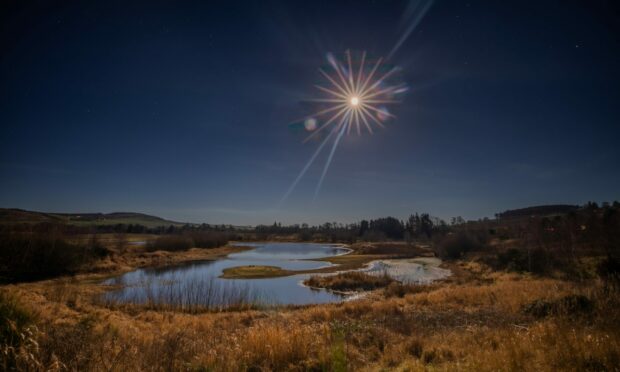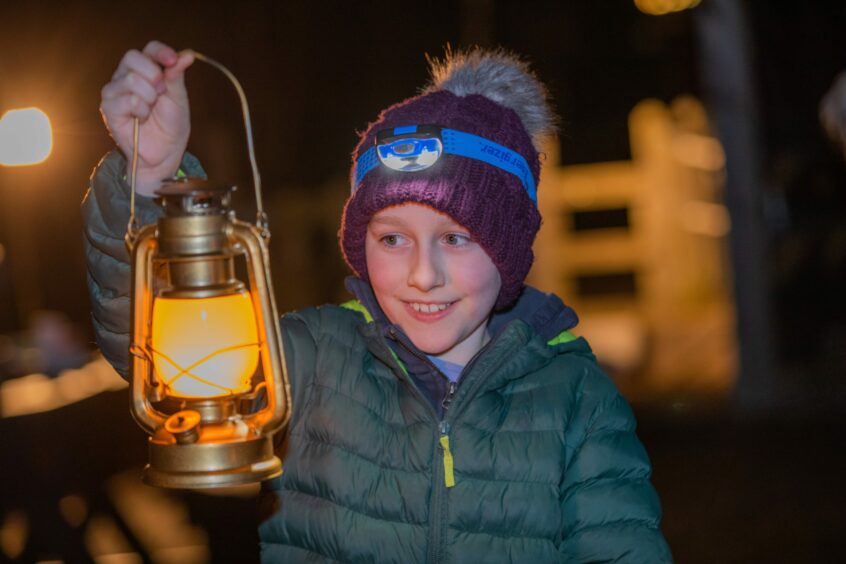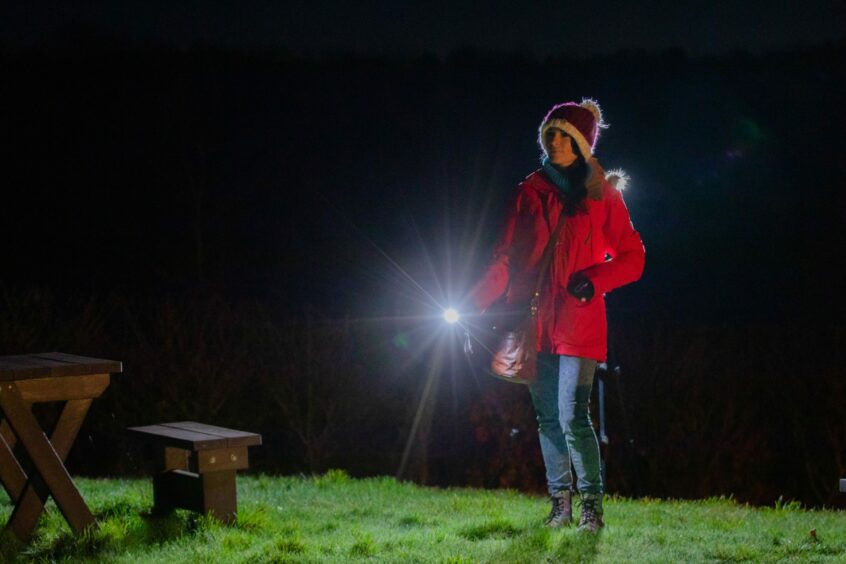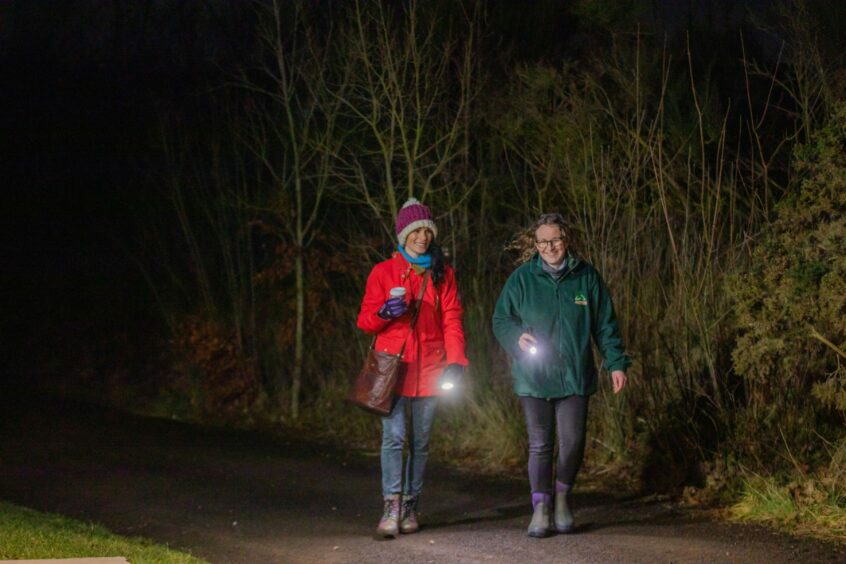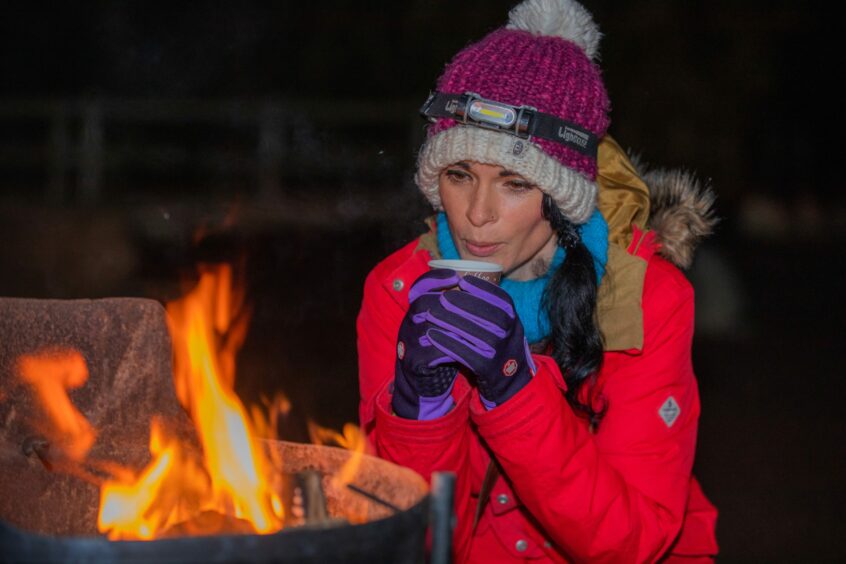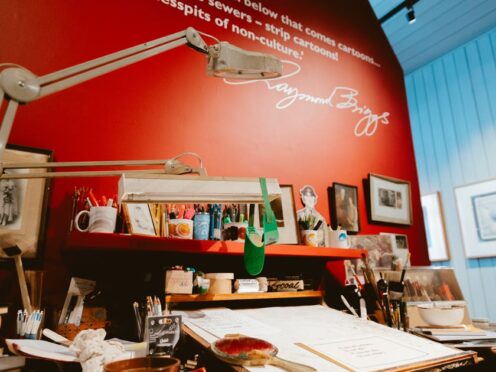Gayle wraps up and heads out on a guided full moon walk around Murton nature reserve near Forfar.
The stars twinkle in the night sky and the moon casts its reflection on to the surface of the loch.
The only sound is the distant hooting of an owl, and the scuffle of something – perhaps a mouse, or a vole – in the undergrowth.
I’m in the heart of Murton nature reserve, a few miles from Forfar, and I’m enjoying a special full moon walk.
It’s a guided event, and I’m joined by a dozen or so others, mostly families with kids.
It’s a cold and frosty evening, and, as I stand, drinking in the peace and beauty of the place, I’m glad I’ve wrapped up warmly.
To my shame, I’ve never explored Murton’s nature reserve until now. It marked its 20th anniversary last year and it’s a fantastic place for a stroll, whatever the season.
The reserve’s stunning lochs and wetlands are home to a variety of birds and wildfowl, including many protected species such as little ringed plover. There are three hides from where you can watch both resident and visiting birds (probably best during daylight!) and it’s a good idea to bring binoculars.
Visiting at night, however, is an altogether different experience. A magical, ethereal, otherworldly kind of experience.
The monthly full moon walks, led by staff and volunteers, are great fun for people of all ages and you’re rewarded with a steaming mug of hot chocolate and toasted marshmallows at the end.
The walk starts off with a gathering round the fire, checking everyone has a torch, and then choosing whether you want to do the long or short loop. I opt for the long one, which is probably a mile or so, and is led by Murton manager Alison Elliott.
Even in the dark, it’s a veritable wildlife oasis – birds of all shapes and sizes flit and flap and we pick out some mute swans swimming in a loch.
History of Murton Farm
I had no clue about the story behind the reserve but Alison tells me Murton Farm was bought in the late 1960s by Michael and Caroline Hill, who were approached by Aggregate Industries about the possibility of sand and gravel extraction on the land.
The Hills agreed on the condition that once the project was finished, the area should be restored to the highest environmental standards.
Caroline, a passionate educationist, and Michael, a staunch environmentalist, decided to form a unique trust for nature and educational purposes – creating a wildlife reserve where children could play and learn and where young disadvantaged people could flourish.
A decade into the project, Caroline died, but her vision has come to fruition and is a precious legacy.
Stunning beauty
The reserve is kept immaculately, with pruned hedgerows, a wildflower meadow, woodland and swathes of mown grass.
There are viewpoints where you can stand and enjoy the views – yes, even in the dark if the moon is bright – that stretch over Murton’s extensive wetlands.
Alison tells us around 130 varieties of bird have been recorded here, including the pair of little ringed plover that nest on gravel.
When we reach one big loch, she encourages us to turn off our torches. It’s so bright we barely need them anyway.
Standing at the edge, the moon shining on the glassy water and the stars on full beam, there’s an amazing sense of joy and wonder.
“It’s not always like this!” laughs Alison. “Some of our full moon walks have been windy and wet – and clouds have obscured the moon. But you’re in luck tonight!”
We pass little tracks made by otters – apparently a few families hang out here – and there’s evidence of red squirrels in the form of chewed pine cones.
Another cool feature is a nesting facility for sand martins on a wall against a bank. Alison explains Murton Trust was a pioneer in creating it and it’s one of the largest man-made sand martin colonies in Scotland.
There are volunteer-made bridges to cross and seats and viewpoints created by volunteers and students which make quiet places for contemplation.
We also pass the grave of Pollyanna, a 40-year-old pet donkey who spent her final years at Murton.
Welcome warm-up
Back at the farm’s tearoom, staff and volunteers hand over welcome mugs of hot chocolate and biscuits.
It’s absolute bliss to get a warm-up by the crackling fire, and the icing on the cake is being given marshmallows to poke into the flames. A real winter treat.
In daylight, you can visit the farm and its friendly animals, including rare breed poultry, kunekune pigs, donkeys and guinea pigs.
Murton Trust provides educational opportunities to encourage learning while developing life skills, as well as maintaining and establishing the nature reserve to encourage people to spend time outdoors.
“It’s important for us to reconnect with the natural world,” says Alison. “We use the site to provide opportunities for young people who have become disengaged with mainstream education.
“But, most of all, we want people to come here, explore and have a fun, amazing experience. And these full moon walks are proving so popular!”
- The next full moon walk at Murton is on February 16 from 6pm to 7.30pm. To book, see murtontrust.org.uk
- Murton also has an outdoor classroom with a large fire pit and several play areas, plus an open shed where courses including chainsaw usage, weaving, spinning and willow weaving can be held.
- Adopt one of the farm’s animals for a year – from £30 for ferrets or £70 for a donkey.
